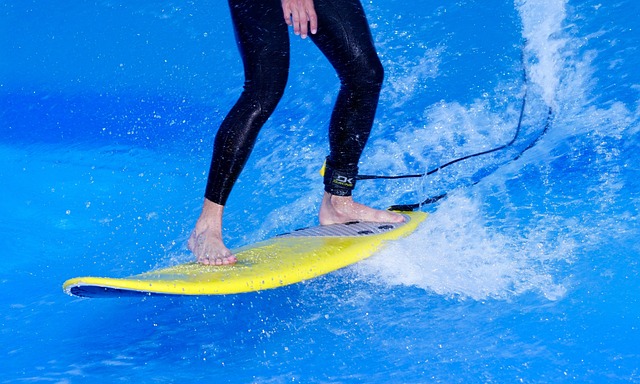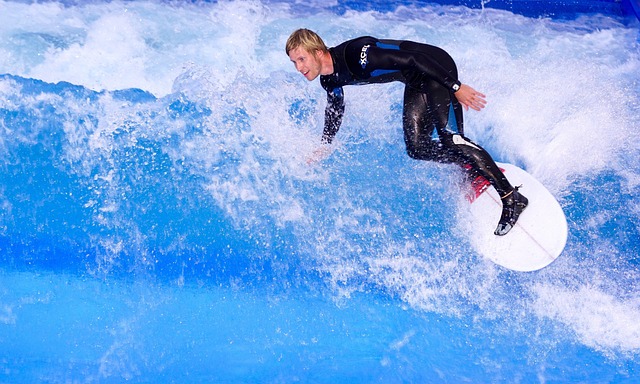Surfing has evolved significantly from its early days of heavy wooden planks to today's advanced, lightweight foam core surfboards that are perfect for beginners. These modern boards offer unparalleled stability, buoyancy, and ease of use, making them ideal for newcomers to learn and gain confidence in the waves. For those just starting out, a soft top foam core surfboard is recommended due to its safe and forgiving nature. It's crucial to choose a board size that matches your physical stature and skill level; beginners should opt for larger boards that provide more floatation. Proper maintenance after each use involves rinsing with fresh water, gentle cleaning, and storing in a cool place to protect the foam core from environmental factors. Regular checks for dings, timely repairs, and fin tuning are essential to keep your surfboard performing optimally as you progress from a beginner to an intermediate surfer.
Embarking on the journey of surfing often begins with selecting the right surfboard, a critical decision that can influence both the learning curve and enjoyment. A surfboard for beginners that stands out in this realm is the lightweight foam core surfboard, offering an optimal balance between buoyancy, maneuverability, and durability. This article delves into the construction, benefits, and evolution of these versatile boards, ensuring readers are well-equipped to make an informed choice. From understanding their anatomy to evaluating performance on the waves, and tips on maintenance, this guide is a comprehensive look at why foam core surfboards are a top pick for those new to the sport.
Understanding Lightweight Foam Core Surfboards: The Beginner's Advantage

For those new to the world of surfing, selecting the right surfboard is a critical step in ensuring an enjoyable and successful experience on the waves. A lightweight foam core surfboard stands out as an excellent choice for beginners due to its manageable weight and resilient properties. These boards are crafted with a high-density foam core, encased within a durable fibreglass or epoxy skin, making them buoyant and forgiving for inexperienced surfers who are still honing their skills. The lightweight nature of these surfboards allows for easier paddling, which is crucial when trying to catch waves, while also providing the necessary floatation to help beginners stand up and maintain balance. This reduces the physical strain on the surfer, making it a more accessible option for those just starting out. Additionally, the foam core design absorbs impacts from wipeouts, ensuring that the board can withstand the trials of learning without the need for frequent repairs or replacements. For beginners looking to advance their skills without investing in multiple boards, a lightweight foam core surfboard is an ideal first choice that offers both versatility and durability.
The Anatomy of a Lightweight Foam Core Surfboard

When selecting a surfboard for beginners, the anatomy of a lightweight foam core surfboard is pivotal to understanding its performance and suitability. These boards are typically constructed with a high-density polyurethane foam core, which provides the necessary buoyancy and floatation without being overly heavy. This core is enveloped in a protective glass fiber layer, known as the “skin,” adding strength and durability to the board while maintaining its lightweight characteristics. The deck, or top surface of the surfboard, is often covered with a soft, skid-resistant material, such as traction pad or sandpaper, to enhance grip and control during transitions on the wave face.
The structure of a foam core surfboard is designed for ease of use, making it an ideal choice for novices. The rails, or edges of the board, are softer and wider, offering a more forgiving platform that’s less prone to catching waves or flipping during wipeouts. This design feature, along with a slightly longer and wider outline than high-performance boards, provides beginners with stability and paddling efficiency, crucial for catching waves effectively. The fin setup on these boards is typically a single fin center with two smaller side fins, known as thrusters, which offer a balance between speed and directional stability, guiding the board through the water with minimal effort. This combination of characteristics makes lightweight foam core surfboards an excellent entry point into the world of surfing for beginners seeking a user-friendly and accessible experience on the waves.
Key Benefits of Choosing a Foam Core Surfboard for Beginners

For novice surfers seeking a balanced and forgiving board, lightweight foam core surfboards stand out as an optimal choice. These boards are engineered with a high-density foam core, sandwiched between durable fibreglass or epoxy skins, providing both buoyancy and resilience without compromising on performance. The buoyancy of the foam ensures that beginners can easily paddle into waves, while the forgiving nature of the board lessens the chance of injury when wipeouts occur. Additionally, the lightweight design makes it easier for beginners to maneuver the board, enhancing their learning curve and allowing for a more intuitive understanding of wave dynamics.
The stability offered by a foam core surfboard is another significant advantage for those just starting out. The wide distribution of buoyancy across the board’s core provides a solid platform from which to develop balance and timing. This stability, combined with the softness of the core material, reduces the likelihood of the board ‘snapping’ under the rider’s weight, which is a common concern with harder materials. Furthermore, foam core surfboards are typically more affordable than their traditional wooden or high-tech composite counterparts, making them an accessible option for beginners looking to invest in their new hobby without breaking the bank. This cost-effectiveness, when paired with their user-friendly characteristics, makes foam core surfboards a highly recommended choice for those embarking on their surfing journey.
Types of Foam Cores in Surfboard Construction

When selecting a surfboard tailored for beginners, the type of foam core used in its construction plays a pivotal role in performance and comfort. Surfboards for novices often feature polyurethane (PU) foam cores due to their balanced weight-to-strength ratio. PU foam provides the necessary buoyancy and resilience, making it easier for beginners to paddle, catch waves, and maintain stability without excess fatigue. Additionally, PU cores are versatile enough to be shaped into various designs, accommodating a range of surfboard styles suitable for different conditions that a beginner may encounter.
Another common foam core material used in entry-level surfboards is polystyrene (PS) foam. Polystyrene offers a lighter option compared to PU, which can be advantageous for beginners who might find the heaviness of a PU board challenging, especially when learning to stand up and maneuver. The reduced weight of a PS core board makes paddling more efficient, enhancing the overall riding experience for those just starting out. Furthermore, the lighter density EPS (Expanded Polystyrene) foam is also gaining popularity in the production of beginner surfboards due to its lightweight nature and excellent thermal insulation properties, which can lead to improved performance and durability without significant added cost. Whether choosing PU, PS, or EPS, the right foam core can significantly influence a beginner’s comfort and progression in the sport of surfing.
Evaluating the Performance: How Foam Core Surfboards Handle Waves

When considering a surfboard for beginners that can offer both stability and performance, lightweight foam core surfboards emerge as an excellent choice. These boards are crafted with a high-density foam core, sandwiched between durable fibreglass cloth and a polyurethane resin coat, providing a solid yet forgiving platform for newcomers to the sport. The foam core’s lightweight nature allows for easier paddling, a crucial aspect for beginners looking to catch waves effectively. Its buoyancy ensures that riders can maintain balance and floatation, reducing the likelihood of wipeouts and fostering confidence as they navigate through the initial learning curve.
In wave handling, foam core surfboards demonstrate impressive agility and responsiveness. Their design typically features a soft-railed outline, which helps in smoothing out the ride over choppy waters and allows for a more gradual and controlled approach to wave riding. The foam core’s flexibility also plays a role in how the board adapts to various wave sizes and conditions. Beginners can experience a gentle transfer of energy from the wave to the board, enabling longer rides and a better understanding of wave dynamics. This responsiveness not only enhances the learning process but also ensures that as skills progress, the surfboard remains suitable for intermediate conditions, making it a versatile choice for any aspiring surfer’s quiver.
The Evolution of Lightweight Foam Core Technology in Surfing

The development of lightweight foam core technology has significantly transformed the sport of surfing, making it more accessible to enthusiasts and beginners alike. Early surfboards were made from wooden planks and were cumbersome and difficult to maneuver, largely reserved for experienced surfers. The introduction of polyurethane foam in the 1950s marked a pivotal moment in surfboard evolution, leading to the creation of more buoyant and manageable boards. These advancements democratized the sport, allowing beginners to experience the thrill of riding waves without the need for brute strength or extensive experience.
Subsequent innovations have refined the foam core technology, focusing on enhancing performance while maintaining affordability and ease of use, key factors for those new to surfing. Modern lightweight foam cores are engineered with precision, incorporating various densities of foam and strategic shaping to optimize flotation and responsiveness. The integration of stringers, or longitudinal wood or carbon fiber rods, further improves the board’s performance characteristics, offering a balance between stability for novices and agility for intermediate surfers. These developments have made surfboard for beginners not only more efficient but also more environmentally friendly, with sustainable materials and manufacturing processes gaining prominence in the industry.
Selecting the Right Foam Core Surfboard for Your Size and Skill Level

When selecting a foam core surfboard, it’s crucial to consider your personal size and skill level to ensure an optimal experience on the waves. For beginners, a soft top foam core surfboard is often recommended due to its forgiving nature and safety features. These boards are designed with a thicker foam core sandwiched between durable fibreglass or epoxy skin, providing buoyancy and stability that makes them easier to handle for those new to the sport. The size of the board should correspond to your body dimensions; generally, a larger board will offer more floatation and is better suited for larger riders or those who are still mastering the basics. The length and width, along with the thickness of the board, play significant roles in how it performs in the water. A longer board might be more stable but can be harder to maneuver, while a shorter board offers more responsiveness for when your skills advance.
Advanced surfers looking for a foam core surfboard will seek a design that balances performance with their weight and the conditions they typically ride. These boards often come in a variety of shapes, from fish designs for small, weak waves to shortboards or hybrids for more powerful swells. The tail shape and fin setup can also be customized based on your preferred style of surfing. It’s important to work with a knowledgeable retailer or shaper who can guide you through the options and help select a board that fits your size, skill level, and the types of waves you’ll be encountering. With the right foam core surfboard, both beginners and experienced surfers can enjoy the thrill of riding waves safely and with confidence.
Maintenance and Care for Your Foam Core Beginner's Surfboard

When investing in a lightweight foam core surfboard designed for beginners, it’s crucial to adopt a maintenance routine that will preserve its performance quality and extend its lifespan. Regularly rinse your surfboard with fresh water after each use to remove saltwater residue and sunscreen, which can degrade the board over time. Avoid harsh chemicals or abrasive tools during cleaning, as they can damage the foam core. Instead, use a mild soap solution and a soft cloth or brush to gently clean the deck and rail surfaces. Store your surfboard in a cool, dry place, away from direct sunlight and extreme temperatures that could cause warping or delamination.
To maintain the integrity of your beginner’s foam core surfboard, it’s important to inspect it periodically for any signs of dings or stress marks. Repairing minor damage promptly can prevent more significant issues that might compromise the board’s structure and safety. Use a repair kit specifically designed for foam core boards to fix dings. Additionally, consider applying a protective wax coating to the board’s surface to shield it from abrasions and further damage. Regular tuning of the fin setup will ensure optimal performance in the water, allowing you to make the most of your surfing experience as you progress.
